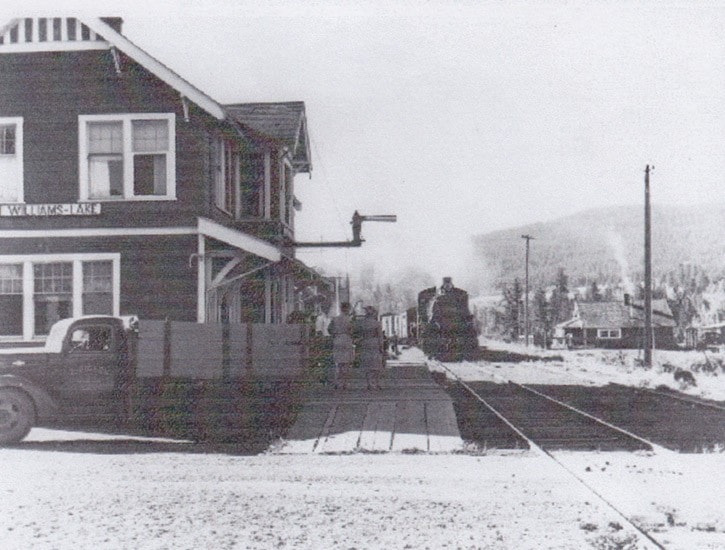I believe the oldest building in our city is the Station House at the foot of Oliver Street.
It is one of only two remaining original company station houses built during the construction of the Pacific Great Eastern Railway (the other one is at Quesnel.)
It is also the second oldest structure still existing on the old PGE line.
Only the water tower, built in 1916 predates it at Lone Butte.
It had been decided during the development of the PGE that Williams Lake would be a major terminus.
A town was planned, designed to allow ease of access to the railway depot.
In the early summer of 1920, Premier John Oliver himself came up by rail to officially establish the Village of Williams Lake.
In honour of this visit, one of the two main streets, Oliver Street, was named after the Premier.
The other main street was named Railway Avenue, and it ran parallel to where the main railway line would be situated.
This street’s name was later changed to Mackenzie Avenue, in honour of one of the area’s leading merchants who established the town’s first store on that street.
The very first train to appear in the Williams Lake Valley was a work train which arrived in September of 1919.
Its construction crew set to work immediately, first building a bridge over Williams Creek, then beginning work on the depot complex with its marshalling yards.
A brand new station house was completed by mid November, and the first Williams Lake station agent, Fred Hutchinson, was appointed.
In January, 1920, the first official passenger and freight train pulled into the station.
There was little fanfare, since there were only a few villagers who lived in the area at the time, and since it was a bitterly cold day.
Hutchinson, like many of the station agents who came after him, lived in the rooms above the station.
These rooms were unbearably hot in the summer months, and very difficult to heat in the winter.
When the trains would go through, the whole building shook. There was no indoor plumbing — the bathroom for both men and women was an outhouse beside the Station House, used by both the travelling public and the station agent and his family.
Over the next couple of years, the town began growing. On Railway Avenue, right across the street from the Station House, was the Lakeview Hotel, Fraser and Mackenzie’s store with apartments above it, a dance hall/event centre owned by Herb Spencer, and Elliott’s Meat Market.
Several small private homes had been built nearby, and in addition, a small tent city had been started.
In those early years, the arrival of the passenger train every week was a major event for the village.
People would head on down to the Station House to see who was leaving and who was arriving.
The train’s passenger list was grist for the town gossip for at least the next week.
On Sunday, July 10, 1921, a young woman was using a gas clothes iron in the apartment above Fraser and Mackenzie’s store. She heard the train coming and rushed over to the Station House but, unfortunately, she left the iron on.
It did not take long before the whole building was on fire. The blaze quickly spread to the other buildings on that side of Railway Avenue.
The men of the village tried to organize a bucket brigade, but it was too late. Several men helped the postmaster carry mail sacks out of the post office which was located in the store.
After only 40 minutes, half the business district was reduced to ashes.
Two cowboys, Johnny Salmon and Bernard Weetman, lost their lives in the fire.
They had been helping to save the mail when the second storey collapsed on them.
They were buried in the cemetery at St. Joseph’s Mission, where their graves can still be seen today.
In 1928, a new station agent, Ted Howard-Gibbons, was appointed.
His wife refused to move into the place unless certain improvements were made. Thus, washrooms were installed on the east side of the Station House, one downstairs for train passengers and one upstairs for the agent’s family.
In addition, the upstairs bathroom now had the luxury of a real bathtub with running water, only the second one in town (I couldn’t find out where the first one was.)
Over the years, the PGE depot, with its Station House, round house, switching yards, water tower, freight buildings and bunkhouses, was one of the major economic drivers for the village.
Most items, from food to dry goods to cattle to lumber, could be and was shipped by rail.
The PGE itself proved to be a good corporate citizen, supplying fresh water for the town, allowing the use of the Station House for civic and school board meetings, and during Stampede time, bringing in old sleeping cars to use as berths for visitors who could not find any accommodations in town.
In the 1960s the PGE freight and operations offices moved over to a new complex on Bagshaw Road, leaving just the passenger waiting room in the old Station House.
The whole depot was in a sorry state of disrepair and, a Tribune editorial called it: “a blot on the landscape.”
In 1981, rather than see it torn down, a group of concerned citizens applied to B.C. Rail for a lease on this historic building to develop it as a home for the arts in Williams Lake.
So began its life as the Station House Gallery.
Over the past 35 years it has served as a showcase centre for local artists and crafters.
It is still in use today, and it remains a valued piece of our city’s colourful history.
